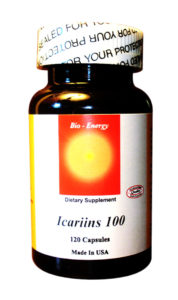Icariins-100

Icariins 100
Icariins 100 contains Icariin , also known as Epimidium, containing a number of flavanoids.
A total of 37 compounds were characterized from the underground and aerial parts of the plant. Among them, 28 compounds were prenylated flavonoids.
The predominant flavonoid, epimedin C, ranged from 1.4 to 5.1% in aerial parts and 1.0 to 2.8% in underground parts.
The large majority are endemic to southern China, with further outposts in Europe, and central, southern and eastern Asia.
Medicinal Function
Aphrodisiac (Arousing Sexual Desire/Sexual Enhancement)
Many species of Epimedium have aphrodisiac qualities associated with content of Icariin. According to legend, this property was discovered by a Chinese goat herder who noticed sexual activity in his flock after they ate the weed.
The active ingredient in Epimedium is Icariin, which can be found in standardized extracts from 5% up to 60% potent. Strengths above that are usually reserved for lab use.
Icariin is purported to work by increasing levels of nitric oxide, which relax smooth muscle. It has been demonstrated to relax rabbit penile tissue by nitric oxide and PDE-5 activity. Other research has demonstrated that injections of Epimedium extract directly into the penis of the rat results in an increase in penile blood pressure.
Icariin, the active compound in Epimedium, inhibits the activity of PDE-5. In vitro assays have
demonstrated that Icariin weakly inhibits PDE-5 with an IC50 of around 1 μM.
Epimedium has been shown to up-regulate genes associated with nitric oxide production and changes in adenosine/guanine monophosphate balance in ways that other PDE5 inhibitors do not. Epimedium may have potential to help sexual dysfunction and osteoporosis.
Osteoporosis
Animal studies indicate that Icariin also stimulates osteoblast activity in bone tissue, leading to the development and marketing of medicinal products based on Epimedium extracts for treatment of osteoporosis.
Very high doses of epimedium can cause side effects of overstimulation, rapid heartbeat, and perhaps heart palpitations.

